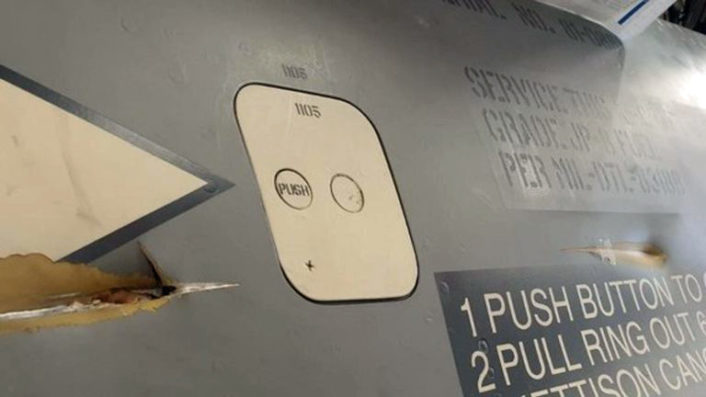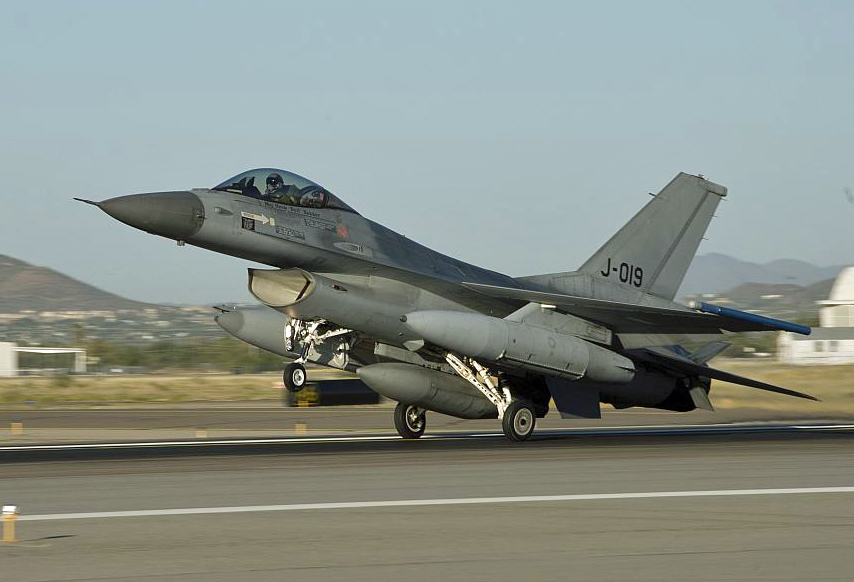Ricocheting bullets can be extremely dangerous.
A Royal Netherlands Air Force F-16 was damaged during live fire training exercises at Vliehors Range on the island of Vlieland in the northern Netherlands, on Jan. 21, 2019.
The aircraft was operating with another F-16 when the incident took place. According to a Dutch media report, the Dutch Viper (as the F-16 is usually dubbed within the fighter jocks community) “suffered considerable damage” caused by its own ammunition.
A photo of damage to the aircraft shows deep longitudinal tears in what appears to be the central fuselage of the F-16. The aircraft was reportedly damaged in the rear section too. Although most details of the incident are still unknown, some media described the event as a case of “plane shooting itself”.
The F-16 is armed with a General Dynamics M61A1 six-barrel, 20mm Gatling gun. The gun is mounted on the left side of the fuselage, below and behind the cockpit. The 248-pound gun is capable of firing up to 6,000 rounds per minute.
The reported muzzle velocity of the F-16’s M61A1 cannon is “3,450 per second”, while the top speed of the F-16 is about 2,200 feet per second or 1,500 miles per hour. That makes the likelihood of an F-16 actually “catching” its own bullets in flight largely impossible.
Some aviation journalists are comparing this latest incident to a September 21, 1956 incident when a U.S. Navy Grumman F-11F Tiger collided with its own 20mm cannon shells in flight. That aircraft was completely destroyed in the incident and the pilot was wounded. But that appears to be a completely different story: the Tiger started the run at 20,000ft, 20 degrees nose-down. At 13,000ft, the pilot fired a four-second cannon burst, then advanced the throttle to afterburner, steepened his descent, and fired a second burst. Three bullets hit the aircraft at lower level, one of those damaged the engine.
However, the one on Jan. 21, 2019, appears to be “just” a case of ricocheting bullets.
Plane shoots itself? It seems a poorly worded description of what is probably a case of ricocheting bullets. Any pilot engaging a firing range for strafing runs knows this can happen under certain conditions. https://t.co/uz1NRiQjRP
— David Cenciotti (@cencio4) April 9, 2019
Fighters that use the gun on ground targets inside firing ranges face the risk of ricocheting bullets. In order to have an idea about the way combat aircraft engage a range for training events that involve the use of live ordnance (on one of Europe’s largest ranges), read this article published by this Author some months ago. Here’s an excerpt:
Two kind of training events can take place inside Frasca range: “hot” (when inert weapons are dropped) and “dry” (when no armament is dropped). The same sortie usually includes some dry passages, needed to get accustomed to the range environment and targets, followed by hot ones. The targets are easily identifiable wooden pyramids or cubes, located in the north of the peninsula: represented by various white circles, they are numbered to distinguish them from one another in radio communications with the RSO (Range Safety Officer), who works in the range control tower alongside two non-commissioned officers, responsible of the electronic sensors.
These sensors are a series of cameras that triangulate the impact of the dummy bomblets on the target, for all the events that involve inert bombs; microphones that detect the shock waves of the inert bullets for all the gun strafing events
Each target is assigned a specific racetrack or pattern, an attack profile, a final heading that is designed so that the bombs can’t fall outside the perimeter of the range, and, based on the characteristics of the terrain, a type of inert weapon. For instance, the one used for training with the gun consists of two panels (right and left) installed onto a terreplein that serves to reduce the hazard of ricocheting bullets.
Bullets fired by the jet’s gun can literally bounce on the terrain depending on the type of surface, dive angle of the aircraft and distance from the “foul line”.
“The risk of ricocheting bullets significantly increases when the aircraft points at the strafe target with an angle of 20 degrees or less,” says The Aviationist’s contributor and former combat pilot Alessandro “Gonzo” Olivares. “Throughout my career, I have heard several cases of aircraft hit by their own bullets; some jets were also lost because ricocheting bullets hit the engine forcing the pilot to eject. Indeed, what appears somehow weird about the Dutch F-16 mishap, is not the fact that the aircraft was hit but that it was hit in the front part of the plane: because of the terrain, bullets randomly ricochet and usually hit the aircraft during the recovery phase concentrating in the middle or rear part of jet, although I’ve also heard of rounds penetrating the cockpit! Anyway, for sure, the aircraft did not reach its own bullets during the dive: when I flew the Tornado, we strafed from 3-4,000 feet and you could see the bullets hitting the terrain when you were still pulling the trigger!”

There have been several extraordinary incidents with aircraft ordinance over the previous years in Europe. In October, 2018, a Belgian Air Force F-16 accidentally fired its M61A1 cannon while parked for maintenance at Florennes Air Base in the Walloon area of Southern Belgium. It completely destroyed another F-16 parked nearby.
In August of 2018 a Spanish Eurofighter Typhoon accidentally fired an AIM-120 AMRAAM (Advanced Medium-Range Air-to-Air Missile) near the city of Otepää in Estonia, only 50 km west of the Russian border.
Back in November, 2013, journalist Jacek Siminski of TheAviationist.com reported that a Dutch F-16 accidentally strafed a range control tower on the Vliehors Range, just one of a series of similar incidents on the range.
Tom Demerly has contributed to this post.









